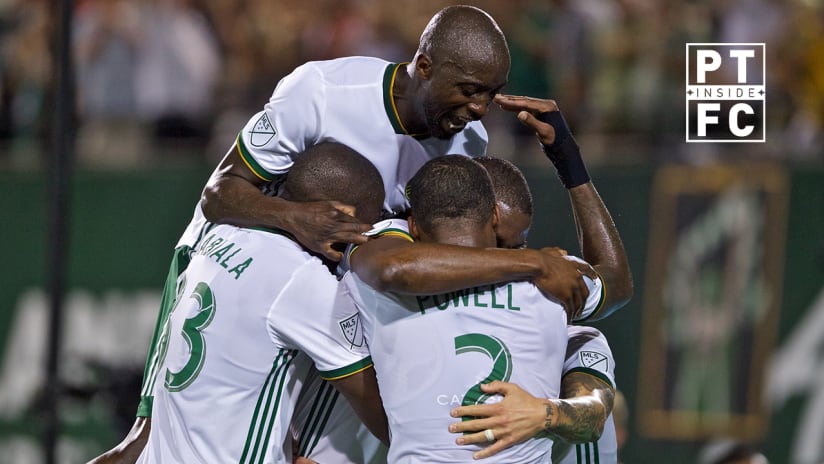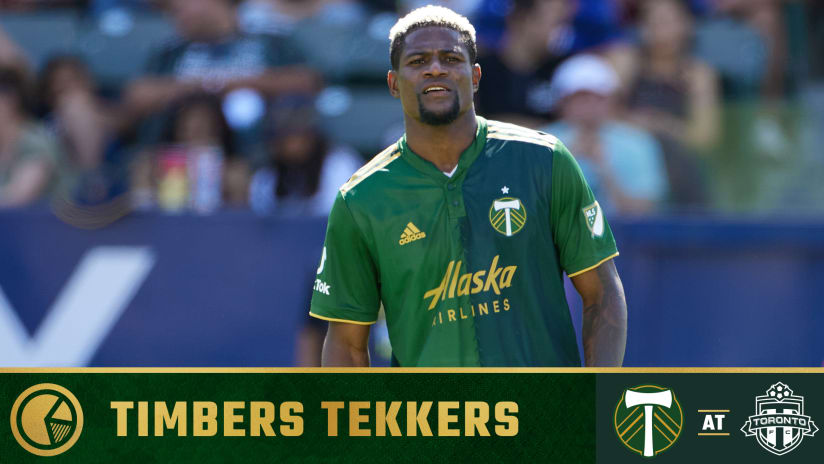An era ended on Saturday night, doing so gloriously, in a moment that feels destined to go down among the most famous in the Portland Timbers’ time at Providence Park. “I was there for Fanendo Adi’s last game,” 50,000 Portlanders will inevitably say, ignoring the fact the park’s 2018 configuration could hold nothing close to that number.
That exaggeration is only right considering the level of love that poured out of the North End when Adi scored his 80th minute winner, delivering a 2-1 victory over the visiting Houston Dynamo. Now, though, the team has to deal with the aftermath. On the depth chart as well as culturally, there is a hole in the Timbers’ system.
How those holes get filled will be heavily influenced by the haul that was announced this morning, with Portland securing at least $850,000 in allocation monies ($450,000 of it General Allocation Money, for now) in a trade with FC Cincinnati. Combine those resources with the open roster spot and the Designated Player vacancy, and the Timbers have a number of options.
But first, let’s consider the challenges.
Don’t underestimate the fit
Adi’s four years in Portland weren’t without drama, but by the time this preseason came around, it was clear that the 27-year-old Nigerian was becoming a learned presence within the squad’s culture. In a locker room comprised of a number of focal points, Adi had become a distinct one, with a series of younger players seeing him as a leader. The increased perspective fans saw on camera whenever Adi faced the media was evident off camera, too. There was a growing zen to the new father that saw his role in the team evolve.
When you lose players like that, it is different. The first training sessions without Adi are going to feel weird, and in the occasional silences in the locker room which make former teammates pause and consider whether those gaps existed before, players will realize they were instinctively pausing, waiting for Adi’s voice fill the room.
“It’s hard,” Diego Chara admitted, after Saturday’s game, when asked about the departure. “It’s hard to miss people like Adi. But, this is the soccer life. I wish the best for him, for his family, [but] that’s soccer.”
In a few weeks, there will be a new normal to life in the squad. Life in soccer goes on, even if it doesn't go in the same way, for now. For a while, the Timbers will have to get used to filling those new spaces in the room.
And then there’s the roster
When Samuel Armenteros was acquired this winter, Gavin Wilkinson was clear about the depth chart: The team wanted to recreate the dynamic it had when Adi and Maxi Urruti were in the same squad.
It’s something that hasn’t been repeated enough by people like me as debates have ranged around Armenteros’s emergence. Ideally, it wouldn’t be an Adi or Armenteros world. It would be Adi and Armenteros.
Obviously, that’s not the case, leaving the Timbers devoid of a very distinct option. As fans saw when Adi came off the bench this weekend, there is a ferocity to a player of his kind that your team needs, from time to time. Ideally, some of those times would be in a starting XI, against teams that either can’t handle a player of that power or are going to be susceptible to his style.
Who’s left on the Timbers roster that can fill that need? Players like Jeremy Ebobisse or Dairon Asprillacan do their best, but that’s not their ideal role. They’re players of a different style. While a number of teams get by without an Adi-esque talent (think Atlanta United FC, or New York City FC), even those teams would be better off for having the option.
Now, Portland no longer has the option, giving Wilkinson a new item on his to-do list, going forward.
“The objective of the club is to bring in another No. 9,” Wilkinson explained, “to give the coaching staff a quality player to select from while also making sure every player that starts feels a healthy pressure to perform.”
An opportunity to step up
In terms of silver linings, that is where Ebobisse comes in. As does Foster Langsdorf. As do the other players who could potentially see more time at forward.
Ebobisse has lingered in fans’ minds after the contributions he made during this rookie season, when he collected one goal and three assists in 317 Major League Soccer minutes. This year, with the first team’s enhanced depth, Ebobisse has spent much of his time with Timbers 2, scoring three times in 903 USL minutes while sharing time with Langsdorf, whose is adapting to his first season as a professional. Back with the Timbers after a stellar career at Stanford, the Homegrown Player has 10 goals in his first 1,200 minutes with T2.
Asprilla and the newly assigned Tomás Conechny can also play up top, but another option may be Lucas Melano. Successful spells on loan in Argentina, where he found success in Copa Libertadores, have made the return of the Portland loanee increasingly possible, with the 25-year-old potentially fitting an area of need within the squad. Close to obtaining his green card, Melano could return without having to occupy an international spot, increasing the value of a player who made significant strides with Estudiantes last season.
For any of those options to completely fill Adi’s shoes, though, is a big ask, but thanks to the emergence of Armenteros, they may not have to. Part of the luxury of dealing Adi comes from having another starting option.
The Designated Player label
That Armenteros has claimed the role gives us some insight into the Timbers’ philosophy toward their Designated Player spots. Highly-paid, limited to three, DP spots (and the salary cap breaks that come with them) are among the most valuable commodities for teams willing to pay for high-level talent. But that value of that commodity quickly wanes when a DP loses his starting spot. What should be a huge efficiency – a seven-figure talent hitting your salary cap for mid-six-figures – becomes grossly inefficient when they’re not on the field.
That’s part of the reason Monday’s deal needed to happen. As the announcement implied, the demand for Adi was still reasonably high within Major League Soccer. Would it have been the same five months from now if Adi didn’t reclaim time from Armenteros? With two more years on the player’s deal, it was a risk the team had reason to avoid.
How Portland uses their new flexibility will play out over the next weeks and months, but even before those decisions are made, we’ve learned something about the team’s approach to its Designated Player spots. If the team is going to maximize its assets, it can’t have one of its important roster spots resting outside the first XI. For the Timbers, Designated Players have to be making an impact on the field.
Preserving the squad’s depth
Beyond that spot, the acquisition of at least $850,000 in allocation money will, come 2019, help replicate an effect we saw last winter, when a large sum came in the Darlington Nagbe trade. Thanks in part to that deal, the team had the resources to acquire players like Armenteros, Julio Cascante, Cristhian Paredes and Andy Polo, as well as pay down cap hits and fit the squad's new depth onto the 2018 roster.
The departure of Adi could have gone a different way, though. Having suitors overseas, Portland could have freed up their resources with a traditional transfer, with the money brought in allowing them the recoup the investment made when they brought Adi in from FC Copenhagen. Any profit could have then, in part, been put back into the roster in the form of General Allocation Money, per MLS rules.
With support of ownership, though, Wilkinson was allowed to go a different route. By trading Adi within MLS, the team was able to make a pure allocation deal.
“This allows the team to put all of the resources from Adi’s departure back into the strengthening the team for 2019,” Wilkinson explained. Instead of having to account for the original investment first, all of the proceeds from Monday's deal can, come 2019, go back into the squad.
Crucially, that influx of money will help Portland preserve the depth its built. The same approach to roster management that has enabled 2018’s early success, as well as address some of the shortcomings that undermined the team at the end of 2017, can continue. And, perhaps as important, the team can operate throughout the rest of this season knowing that, come 2019, it won’t need to make as many compromises for lack of resources.
There are always going to be misgivings when you trade somebody as important as Fanendo Adi - qualms that impact a team’s outlook on the field and off. But with any trade comes a set of new realities, too, as well as new resources.
Thanks to the compromises the team’s made, those opportunities have begun presenting themselves. And if the right decisions are made, the Timbers could be stronger for them.












